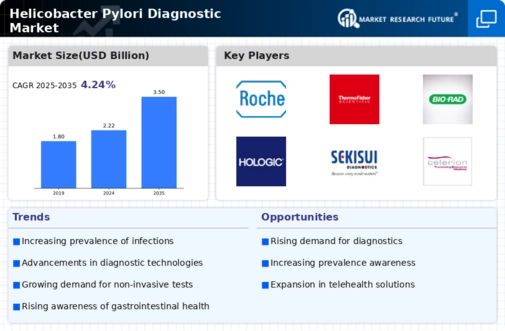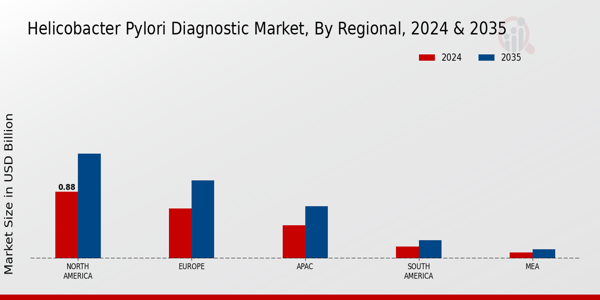Market Growth Projections
The Global Helicobacter Pylori Diagnostic Market Industry is projected to experience substantial growth over the coming years. With a market value expected to reach 2.22 USD Billion in 2024, the industry is poised for significant expansion. The compound annual growth rate of 4.23% from 2025 to 2035 indicates a robust market trajectory, driven by various factors such as technological advancements, increasing prevalence of infections, and rising awareness. These projections reflect the dynamic nature of the market and the ongoing efforts to enhance diagnostic capabilities for Helicobacter Pylori, ensuring better health outcomes for affected populations.
Growing Demand for Point-of-Care Testing
The increasing demand for point-of-care testing (POCT) is a notable driver in the Global Helicobacter Pylori Diagnostic Market Industry. POCT offers rapid results, enabling timely clinical decisions and improving patient outcomes. The convenience of conducting tests in various settings, including outpatient clinics and pharmacies, enhances accessibility for patients. As healthcare systems strive to improve efficiency and reduce costs, the adoption of POCT for H. Pylori diagnosis is expected to rise. This trend aligns with the overall market growth trajectory, as the industry adapts to meet the evolving needs of healthcare providers and patients alike.
Rising Awareness and Screening Initiatives
Increased awareness regarding the health risks associated with Helicobacter Pylori infections is driving the Global Helicobacter Pylori Diagnostic Market Industry. Public health campaigns and initiatives aimed at educating populations about the symptoms and complications of H. Pylori infections have led to a surge in screening efforts. Governments and health organizations are promoting early detection strategies to mitigate the risks of severe gastrointestinal diseases. This proactive approach is likely to enhance the demand for diagnostic tests, thereby supporting market growth. The anticipated compound annual growth rate of 4.23% from 2025 to 2035 reflects the positive impact of these initiatives on the market.
Technological Advancements in Diagnostic Methods
Technological innovations in diagnostic methodologies are significantly influencing the Global Helicobacter Pylori Diagnostic Market Industry. The introduction of non-invasive testing methods, such as breath tests and advanced serological assays, has enhanced the accuracy and efficiency of H. Pylori detection. These advancements not only improve patient compliance but also reduce the burden on healthcare systems. For instance, the development of point-of-care testing devices allows for rapid diagnosis, which is crucial in managing H. Pylori-related conditions. As these technologies evolve, they are likely to contribute to the market's growth, with projections indicating a market value of 3.5 USD Billion by 2035.
Increasing Prevalence of Helicobacter Pylori Infections
The rising incidence of Helicobacter Pylori infections globally serves as a primary driver for the Global Helicobacter Pylori Diagnostic Market Industry. According to health statistics, approximately 50% of the world's population is estimated to be infected with this bacterium, which is linked to various gastrointestinal diseases, including peptic ulcers and gastric cancer. This high prevalence necessitates effective diagnostic solutions, thereby propelling market growth. As awareness of the health implications associated with H. Pylori increases, the demand for accurate and rapid diagnostic tests is expected to rise, contributing to the projected market value of 2.22 USD Billion in 2024.
Expansion of Healthcare Infrastructure in Emerging Markets
The expansion of healthcare infrastructure in emerging markets is contributing to the growth of the Global Helicobacter Pylori Diagnostic Market Industry. As countries invest in improving their healthcare systems, access to diagnostic services is becoming more widespread. This development is particularly evident in regions with high H. Pylori prevalence, where enhanced healthcare facilities are facilitating better screening and treatment options. The increasing availability of diagnostic tools and technologies in these markets is likely to drive demand, supporting the overall market growth. The anticipated increase in market value to 3.5 USD Billion by 2035 underscores the potential of these emerging markets.


















